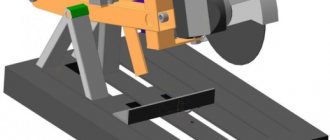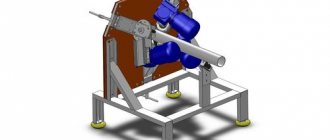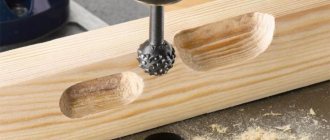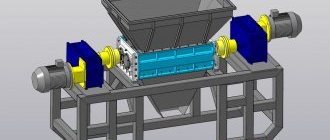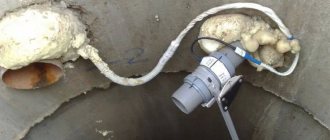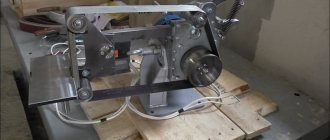In this article we will figure out how to make a miter saw from a grinder, but at the same time you will have options where you can use your device as a circular saw or to trim metal profiles. As the story progresses, I will mention the parts that will be needed for cutting lumber and which ones will be needed for steel products. Essentially, you will get a universal unit that will be an excellent tool for your home workshop.
What does a lathe consist of: main components
For the most part, industrial and household lathes are similar. The difference lies in functionality, power and weight. The figure below shows the structure of a typical screw-cutting lathe. The main nodes are:
- bed;
- caliper;
- headstock (placement of the gearbox to adjust the rotation speed and change the amount of torque);
- tailstock (for more stable and reliable support of the workpiece or part clamped in the chuck (spindle), as well as for installing drills, taps and other tools);
- tool holder
The device of a screw-cutting lathe
bed
One of the main elements is the frame - a massive metal base on which all the main components and parts of the equipment are mounted. It must be strong enough, and the mass must be such as to prevent the machine from tipping over during operation. For the floor version, massive supports (pedestals) are added.
Lathe bed
Lathe support
The lathe support is designed to move along, across and at an angle to the spindle axis of the cutters fixed in the tool holder. The device has a cross design, consisting of three main elements: a carriage, a transverse and a cutting slide.
Metal lathe support for home
Making your own lathe headstock
The headstock is one of the most difficult components of a lathe, especially for DIY production. It houses a gearbox with a spindle and a control unit. Under the headstock casing there is an electric motor, which is connected by a belt drive to the gear pulley.
Homemade headstock assembly with chuck
This unit contains a block consisting of replaceable gears designed to transmit and change the spindle rotation speed and torque from the feedbox shaft. You can buy a lathe headstock or make one yourself.
Guitar lathe
Lathe tailstock
The tailstock of a metal lathe is movable and is designed to press the workpiece to the center of the spindle. One of the elements of this unit is a quill, on which a stationary or rotating center is installed, the tip of which rests on the workpiece. The workpiece is installed in a chuck on the spindle and supported by the tailstock. This ensures reliable fastening of the part for high-quality processing.
Metal lathe tailstock
Drills, taps, countersinks, etc. can be installed in the tailstock. When installing and moving on the skids of the frame, it is necessary to avoid sharp and strong impacts on the body of the unit in order to prevent displacement of the centers.
Tailstock detailing
Making your own tool holder for a lathe
The tool holder is designed to attach a metal processing tool to the support of a lathe and moves both in the longitudinal and parallel directions relative to the workpiece. There are two types of tool holders: two- and four-position. In the first case, you can simultaneously install two cutters using screws, and in the second - four, which allows you to quickly change cutters if necessary without stopping the lathe. A special handle is provided for quickly changing cutters.
Tool holder for metal lathe
Functional front lock
For figured turning, the workpiece is fixed between two clamps, which are usually called headstocks. At the same time, torque from the electric motor is transmitted to the front, and therefore it will be somewhat more difficult to assemble it.
The front clamp of a home lathe is an iron U-shaped structure, between the sides of which a shaft and a pulley system are mounted on bearings. The body is assembled from thick rolled steel segments.
What other types of machines can be made?
Before creating your own lathe, you should study those varieties that were invented by many interested people. Among the machines, both home-made and factory-made, the following types are distinguished.
Turning and milling
Such a machine is already a powerful modification of previous versions of machines. Most often, a turning and milling machine is equipped with a CNC, because it is extremely difficult to manually control the milling machine with high precision. However, such a machine has a right to exist and is widely used for domestic needs. Its design consists of:
- Beds.
- Electric motor for rotating the headstock.
- A manual milling cutter placed on guides that ensure its movement along the axis of rotation of the workpiece.
With a copier
A lathe and copying machine is necessary when creating a large number of identical products; most often you hear about dishes and balusters for stairs.
There are several options for making a copy lathe: with a router, with a circular saw and with a chisel. All these methods involve the use of patterns. A pattern is a profile of a future product, which is cut from thin plywood.
A handrail is attached along the lathe along the entire length of the workpiece. The pattern is mounted behind the lathe. A cutter or cutter is attached to the handrail, the movements of which are regulated thanks to a stop running from the cutter, cutter or saw to the pattern.
Thus, during the rotation of the block, the cutting tool completely repeats the silhouette of the plywood profile with sufficient accuracy.
Mini
For many household needs, it is not necessary to create a unit of impressive size, capable of rotating a log with a radius of 300 mm. Sometimes a machine with an extremely simple design is sufficient, in which the engine can be a drive from an old tape recorder, powered through a power supply. For the bed of such a machine, you can use a board 150 * 20 and long, which depends only on the needs of the craftsman.
For such a mini-machine, a belt drive would be superfluous, so most often the headstock is mounted directly on the motor shaft. And the head from a drill or a homemade chuck with three clamping screws serves as a faceplate.
The tailstock is made of a block, in the center of which a hole for the shaft is drilled exactly at the height of the motor axis, which can be a dowel-nail. If you provide the machine with a power supply with adjustable output voltage, you can get the unit with a speed controller.
From an electric drill
An electric drill can be found in almost every home. The advantage of a machine driven by an electric drill is that there is no need to buy a separate motor. Drill-powered designs range from the most basic, where the drill is clamped to the table.
On the contrary, the tailstock is mounted using a pair of angles and a nail or a sharpened screw, to a more advanced one, in which the drill serves as a source of rotating force, but is not directly involved in the process of rotating the workpiece. The second method protects the motor from overheating and stalling under overload.
From a washing machine motor
It is a standard layout of a lathe with a motor, direct or belt drive, bed and two headstocks.
When constructing a lathe from a washing machine motor, it is necessary to remember that the motor of a household appliance is designed to circulate with an unbalanced load, but this does not mean that the tailstock can be abandoned. Its presence is mandatory especially when working with long and heavy workpieces. The design of such a lathe is easy to implement at home. To do this you need:
Weld or bolt two steel pipes and attach a motor from a household appliance to one end. Fix a block between the pipes with the ability to move it along the frame; the corner of the tool rest will be attached to it. On the opposite side, the tailstock is installed in accordance with the instructions outlined above.
Installation of the second clamp
The purpose of the rear analogue is to support the conditional cylinder to be sharpened and provide it with freedom for rapid rotation. The more firmly the tailstock holds the workpiece, the better the final result will be.
- An indispensable condition for proper installation of the second clamp is maintaining alignment with the first.
- Faced with great difficulties at this stage, it makes sense to significantly simplify the task by purchasing a completely finished unit.
The use of an electric drill chuck will allow you to significantly modify the engineering solution. A shaft is clamped in it, the end of which must be pointed.
What does a lathe consist of?
Typical design
Even a small lathe weighs a lot and creates vibrations during operation. A reliable frame (1) is required, on which functional units and individual parts are secured. If you plan to create a floor version, use reliable supports of the required length. The final height of the work area should be user-friendly.
The following list contains other components:
- The front headstock (3) houses the gearbox. It is designed to adjust the spindle (4) rotation speed and change the torque value.
- On the reverse side, the workpiece is supported by the tailstock (6). If necessary, taps, drills, and other tools are also installed here.
- In the standard processing mode, the cutters are fixed in a special holder (5).
- This unit is mounted on a support (8). For smooth horizontal movement, a screw mechanism located in the apron (7) is used.
- The feed box (2) drives the drive shaft.
Lathe support
Device
Notes on the drawing:
- the carriage (1) and the entire block as a whole (17) are driven by the running shaft (2);
- the movement mechanism is connected with a special handle (15);
- these slides (3) provide freedom of movement of the upper part in the transverse direction (12);
- it is mounted on a rotating unit (4) with longitudinal guides (5);
- the cutters are installed in the holder (6);
- screws (7/8) are used to secure this part/tools;
- the handle (9) can be used to safely move the cutters at a distance from the working area;
- fastening element (10) of the upper part (11);
- for its precise movement in the appropriate directions, handles (13, 14) with a screw drive are used;
- The flywheel (16) moves the caliper manually.
When studying this part of a metal lathe in detail, it is necessary to take into account the increased loads to which it is exposed during technological operations.
It is necessary to pay attention to the large number of moving components
Maintaining precision requires more than just durable parts. Constant adjustments will help eliminate play to compensate for wear. It is recommended to replace damaged seals with new products.
Tailstock
Main components of the unit
Here and further we will consider projects that are easy to reproduce on your own with clarifying comments. The example in the figure is more suitable for woodworking equipment. To work with durable workpieces for a long time, you should make a support shoe from a steel plate.
In addition to the standard equipment, such replacement devices will be useful
With their help, the basic capabilities of the tailstock are expanded. The author's recommendations suggest removing part of the standard cartridge mount (3). This will allow you to increase the working stroke of the tool and process larger workpieces.
Features of making a lathe headstock with your own hands
Simple design solutions are used to make homemade products.
A belt drive (1) is used here, which is characterized by its low cost and low noise level. For stepwise change of torque, a double pulley (2) is installed. To extend the life of the spindle (3), you need to use a pair of ball bearings. If necessary, holes are made in the housing for periodic filling of lubricant.
As a rule, a metal lathe is equipped with three-jaw chucks
These clamps center automatically without further adjustment. Making such units yourself will cause difficulties. Therefore, you can buy this functional element of the headstock of a lathe in a store.
Models with four jaws are used for processing square workpieces.
How to make a tool holder for a lathe with your own hands
It is better to make the main part of the holder in a collapsible design
This will allow you to make repairs without unnecessary difficulties. Bolts are screwed into the threaded holes to firmly secure the tool. The distance between the plates is determined taking into account the size of the cutters.
A handle is installed on top to quickly turn the unit. This device allows you to quickly change tools for complex sequential processing of workpieces
Convenient turntable
All that remains is to make a tool rest, where needle files, jigsaws, sandpaper, planes and hacksaws will be laid out during work. Its outlines are not regulated in any way, but it must be completely comfortable.
It is better to design such a table with the participation of the master who will become the main user of the automatic sharpener.
The best option is a swivel stand in the shape of a trapezoid. It is cut out of a thick iron sheet, after which it is mounted on a rotary hinge with a large two-way angle. It will be easy to move such a table in order to bring files closer to you or move them away for a while.
Design features of the cutting machine
In order for the machine to serve for many years, it must be made of reliable materials. It is better to make metal structural elements from steel alloys, which are particularly hard. In this case, the operation of the finished equipment will be smooth and stable.
It is better to make the platform from heavy, rigid material - a lot here determines the subsequent position of the machine (whether it will be mobile or stationary).
To ensure reliable fastening of the workpiece, you can mount a more complex structure by including a vice as an element.
The disk may have an abrasive surface if it is intended to process the edges of the metal from burrs formed during cutting. This disc is convenient for processing chamfers.
When it comes to stationary devices, it is better to use gear transmission. It guarantees reliable connection and good performance. The belt version is more suitable for mobile devices.
Classification according to the method of feeding the cutting element
There are a large number of machines on sale; before purchasing, it is important to understand how the cutting element feeding system works. The cutting element can be fed in the following ways:
- front feed of cutting disc;
- a device with the implementation of lower feed of the cutting element;
- a structure whose base works in a pendulum manner.
The metal base of the cutting machine can be floor-standing or table-top when used. In the first case, a larger diameter disk is installed, which allows cutting a larger volume of parts. Desktop equipment is more mobile and has a reduced weight.
Cutters of different calibers
Cutting attachments are sold in every major hardware supermarket. At the same time, it is possible to buy both single cutting parts and sets.
With a wide selection of cutters available, the turner will create any complex and intricate configurations, including
- Grooves;
- Chamfers;
- Cones;
- Dashed lines;
- Edging;
- Wavy lines.
Instructions for making a simple lathe with your own hands
Since everyone decides what his lathe will look like and what dimensions it will have, it is impossible to give an accurate description of the manufacture of all parts indicating dimensions, tolerances and fits. However, the process of building any lathe consists of the same steps.
Making the frame. As mentioned above, it is impossible to make a massive cast-iron frame at home. Therefore, its role will be played by a frame made of channel or steel profile pipes, which are cut to size and then welded according to the drawing
It is important to maintain the correctness of all right angles, so control using a square should be carried out every time the next joint is made. It is best to work on a flat, horizontal slab
This will make it possible to obtain a frame with strict geometry in the horizontal plane. You can do without a massive frame by making it from long shafts as guides.
The side posts of the bed are made on a lathe.
Assemble the guides with the posts. In this case, spacer bushings are installed between the side support elements.
Bushings for fastening the tailstock and tool holder are mounted on the guides. It is not necessary to make them the same length. One piece can be made shorter than another by using the long piece as a guide and the shorter piece to support the moving parts. This solution will increase the working stroke of the rear center.
The mounting areas for the quill and caliper are made from a steel sheet 8–10 mm thick and secured to the guides and retaining bushings using bolts with a diameter of 6 mm. Particular attention should be paid to the mounting holes, since the slightest inaccuracy will lead to distortion and jamming of the moving parts of the machine.
Install the lead screw. You can turn this part from a blank or use a threaded part from any device, for example, from a high chair with variable height. Be sure to ensure that anti-friction bushings made of bronze or brass are installed in the corresponding holes in the side posts. A vernier and a steering wheel are attached to the lead screw.
A platform for attaching the headstock is installed, after which the assembly of the frame is considered complete. The headstock is assembled from a bearing support, two ball bearings, a main shaft with pulleys and a spindle.
A tailstock is made from a long screw, a bushing with an internal thread, a metal profile and a handle, after which the rear moving unit is mounted on the machine. Monitor and, if necessary, adjust the alignment of the front and rear centers. Assembling the caliper. The process of its manufacture is similar to assembling the frame - the guides are equipped with bushings, a screw, a vernier and a small steering wheel are mounted. A tool holder is made from a thick metal plate and bolts with a diameter of 8 mm, after which it is installed on the support.
Using a welding machine, an electric motor subframe is made, for which metal corners or profile pipes are used. The subframe must provide raising and lowering of the power unit, otherwise it will be problematic to transfer the belt from one pulley to another to change the spindle speed. The electric motor is mounted and connected, after which a test run is performed.
After the lathe has been tested in operation, its components and parts should be painted. This will add attractiveness to your creation and will not allow corrosion to spoil the equipment you created with your own hands.
A lathe at home is a universal piece of equipment that can be used for purposes other than its intended purpose. A polishing or grinding wheel can be attached to the spindle for sharpening tools or finishing metal parts.
GRINDER MITER SAW – STEP-BY-STEP PROCEDURE OF WORK
From sheet metal 5 mm thick, I cut out a plate measuring 240x50 mm. I welded a bracket made of an iron rod d 10 mm to it. A bolt was welded to the top of the last one
I selected a shaft d 25 mm with an already drilled through hole (the workpiece can be machined from a metal rod). I used a tap to cut a thread inside the hole for the bolt on the bracket. I screwed the shaft onto the bolt to check the smooth running. Then I welded two M10 threaded rods to the shaft wall along the edges. To make them “walk” less during operation, I welded a 5 mm thick metal strip between them.
In the base (metal plate) I marked the place where there will be a slope; it is necessary so that the angle grinder rests against the plate with its entire body. In this area, I marked and drilled a hole so that it coincides with the hole for the handle on the tool.
Holding the base in a vice, I used a hammer to bend its edge to the desired angle. For reliability, I welded the plate between the studs to the shaft and smoothed out the weld using sandpaper. To attach the holder to the table, I cut out two metal plates measuring 100x50x5 mm and drilled holes in them for the pins. When all the parts were ready, I painted them
I cut a rectangular tabletop of the required size from a sheet of chipboard. Stepping back about 20 cm from the edge of the short side, I drilled two holes. I screwed one nut onto the studs and threaded a plate, installed the holder on the table in the holes, threaded another plate from below and screwed on another nut. I attached the grinder to the base. Additionally, I screwed a guide to the table, which I install in two planes relative to the grinder circle - at an angle of 90 and 45 degrees. You can start cutting.
You can draw several corners on the tabletop and set a guide using the marks. To do this, it is enough to loosen one bolt (closest to the device) and unscrew the second. Rotate the guide to the desired angle and tighten the bolts again.
Metal processing machines
To work with metal (especially in mini workshops for the production of metal structures), a variety of machines and devices are used, and many of them can be made with your own hands.
For metal processing, making machines from wood with your own hands is impractical for the reason that they simply cannot cope with the load.
For example, a homemade bending machine (for making half-arcs and rings) is made only from ferrous scrap metal. The design must be reliable.
An automobile hydraulic jack is also additionally used, since the hand strength is definitely not enough to bend the workpiece. And with a jack, the device becomes truly functional.
Making a machine out of wood with your own hands (or rather, just a frame for it) for processing/cutting metal is possible only in a number of cases.
For example, this can be implemented when assembling a cutting machine based on a small grinder. In this case, the base is made of laminated chipboard (you can take plywood).
But all the same, if you are making a machine for cutting metal, then it is better to make the base for it more reliable and durable. You shouldn’t skimp on material here—savings can backfire.
You can weld a simple frame from a profile pipe with reinforcement in the central part, and then weld or bolt a suitable sized metal sheet on top.
A bending machine for bending metal rods and strips also needs a very strong base.
If instead of a sheet of metal there was a plywood board, then the machine simply would not be able to cope with its task.
Therefore, making machines from wood with your own hands for metal processing is possible only in cases where the load on the base (bed) is insignificant. For example, a drill stand or cutting machine.
Support frame base
The bed is a frame that allows you to connect all the parts into a harmonious mechanism. The strength and reliability of such a support directly determines the stability and durability of the entire device. It is better and easier to use a steel angle to make the frame; another suitable material is a rectangular profile.
First of all, it is necessary to mark the dimensions of the assembled automatic sharpening machine. These parameters are determined by what exactly this machine will be used for. As a rule, a stand for an apartment or garage modification does not exceed eighty centimeters in length.
Design and dimensional drawings
Design begins with determining the types of work and sizes of workpieces to be processed. Based on this, we outline the overall dimensions, drive motor power, and bed length. It is not necessary to draw all the details according to GOST. A technical drawing of all details is sufficient.
Calculate drilling points, determine the dimensions of the mating parts. Separately, it is necessary to develop a kinematic diagram and an electrical diagram. In the kinematic diagram, we determine the center-to-center distances of the gears or pulleys of the gearbox. The electrical diagram will make it possible to correctly connect electrical equipment.
What exactly are we talking about?
There are dozens of traditional designs of units for precise cutting of sheet, roll and long materials, not counting lasers, etc. from the age of high technology. We will further consider machines with a swinging working module and a round rotating cutting element - an abrasive or saw blade. Such cutting machines are called pendulum. They are the most versatile (including suitable for broaching - making longitudinal cuts of limited length) and can be done independently in a shed and garage workshop. When they say “cutting machine,” in the vast majority of cases they mean a pendulum cut grinder.
Motor or angle grinder?
This refers to the machine drive - separate or combined in a monoblock with a working (cutting) element and a power transmission to it. A separate motor has the advantage that the swinging part of the unit - the rocker (pendulum, rocker arm) can be made properly balanced, which greatly simplifies the work on the machine and increases its productivity; the latter depends relatively weakly on the cutting resistance of the material
In addition, the entire machine can be made suitable for intensive round-shift work, which can be important for those who earn income with hands that grow in the right place and a head that works as it should. An angle grinder (grinder), as you know, can work continuously for 20-60 minutes
(depending on the model), and then forced technical downtime to cool down the instrument. But for occasional use, an angle grinder has a number of advantages:
- A fairly durable and accurate cutting machine from a grinder can be made without turning parts and with a minimum of welding work or without it at all, see below.
- The basic tool remains suitable for manual work outside the machine.
- Power supply – single-phase 220 V from a household outlet.
- Starting devices and protective grounding are not required, because Only angle grinders with double insulation are widely sold.
- The external characteristic of the commutator electric motor of an angle grinder is softer than that of an asynchronous electric motor with a squirrel-cage rotor, which saves motor power and electricity consumption. In most cases (except for cutting thick, strong and/or viscous materials), we can assume that an 800 W electrical angle grinder is equivalent to an asynchronous motor with 1.2 kW on the shaft (see below), and a 1300 W angle grinder is equivalent to a separate 2.0 kW motor. 2 kW.
- Cutting machines made from angle grinders are lighter, more compact and transportable than those with a separate drive.
- Inexpensive angle grinders are not equipped with speed controllers, but a regular speed controller for a drill is suitable for them (no more than $20; usually $5 - $6). A “frequency generator” for an asynchronous motor up to 2.5 kW costs from $50.
About speed control
Why adjust the disk speed? In order not to exceed the maximum linear speed of the edge and/or rotation speed indicated on it. Otherwise, the disc may not rupture, but its performance will drop significantly, wear will increase, and the quality of the cut will deteriorate. The nominal rotation speeds of asynchronous motors 2800-2850 rpm allow the use of conventional disks with a diameter of up to 350-400 mm or more, which gives a cutting depth of at least 150 mm. The grinder spindle rotates much faster (from 6000 rpm), and placing a regular disk with a diameter of more than 160 mm on it is dangerous. The cutting depth reaches 50-60 mm, and the high-speed disc is expensive and wears out quickly. Installing a speed controller solves the problem. Productivity and cut quality do not suffer, because determined by the linear speed of rotation along the cutting edge.
About the name
An angle grinder sounds “technically”, but in fact it is inaccurate, because... The grinder does a lot more cutting than grinding. The “angle drill” is even worse, because... to drill – to drill, bore, for which an angle grinder is generally unsuitable. An angle grinder is a tracing paper from English. "angle grinder machine". But the English word to grind is much broader in meaning than all types of abrasive processing. For example, a meat grinder is a meat grinder. “To grind” does not have an exact Russian analogue; in meaning it is something like “shred into shreds along the back streets.” In general, the colloquial “Bulgarian” is terminologically incorrect, but it is short enough and it is clear what it is.
Hand power saw
A manual electric circular saw made from a grinder is obtained by replacing the standard cutting disc with a wood cutting disc.
True, this option is suitable for short cuts of sheet materials or cutting thin slats. When cutting long lengths or on thick bars, there is a danger of the disc skewing and jamming. It will be much easier to hold the saw if the handle is not positioned perpendicular to the axis of the tool, but is made an extension of the body.
It is not recommended to remove the protective cover, as it will prevent sawdust from getting into your face.
Craftsmen also make a hand-held chain saw from a grinder. True, such a tool is dangerous for the user: the absence of a chain stopper can lead to unpredictable consequences. In addition, the chain is not lubricated, which leads to rapid wear.
What exactly are we talking about?
There are dozens of traditional designs of units for precise cutting of sheet, roll and long materials, not counting lasers, etc. from the age of high technology. We will further consider machines with a swinging working module and a round rotating cutting element - an abrasive or saw blade. Such cutting machines are called pendulum. They are the most versatile (including suitable for broaching - making longitudinal cuts of limited length) and can be done independently in a shed and garage workshop. When they say “cutting machine,” in the vast majority of cases they mean a pendulum cut grinder.
Motor or angle grinder?
This refers to the machine drive - separate or combined in a monoblock with a working (cutting) element and a power transmission to it. A separate motor has the advantage that the swinging part of the unit - the rocker (pendulum, rocker arm) can be made properly balanced, which greatly simplifies the work on the machine and increases its productivity; the latter depends relatively weakly on the cutting resistance of the material
In addition, the entire machine can be made suitable for intensive round-shift work, which can be important for those who earn income with hands that grow in the right place and a head that works as it should. An angle grinder (grinder), as you know, can work continuously for 20-60 minutes
(depending on the model), and then forced technical downtime to cool down the instrument. But for occasional use, an angle grinder has a number of advantages:
- A fairly durable and accurate cutting machine from a grinder can be made without turning parts and with a minimum of welding work or without it at all, see below.
- The basic tool remains suitable for manual work outside the machine.
- Power supply – single-phase 220 V from a household outlet.
- Starting devices and protective grounding are not required, because Only angle grinders with double insulation are widely sold.
- The external characteristic of the commutator electric motor of an angle grinder is softer than that of an asynchronous electric motor with a squirrel-cage rotor, which saves motor power and electricity consumption. In most cases (except for cutting thick, strong and/or viscous materials), we can assume that an 800 W electrical angle grinder is equivalent to an asynchronous motor with 1.2 kW on the shaft (see below), and a 1300 W angle grinder is equivalent to a separate 2.0 kW motor. 2 kW.
- Cutting machines made from angle grinders are lighter, more compact and transportable than those with a separate drive.
- Inexpensive angle grinders are not equipped with speed controllers, but a regular speed controller for a drill is suitable for them (no more than $20; usually $5 - $6). A “frequency generator” for an asynchronous motor up to 2.5 kW costs from $50.
In general, if you are engaged in assembling metal structures on site and have vehicles, or sell rolled metal (or lengths of wood) with cutting to size from the customer, then you need to make a machine with a separate drive. If trimming and cutting at precise angles is not an everyday necessity for you, then the best option would be a cutting bed for an angle grinder.
About speed control
Why adjust the disk speed? In order not to exceed the maximum linear speed of the edge and/or rotation speed indicated on it. Otherwise, the disc may not rupture, but its performance will drop significantly, wear will increase, and the quality of the cut will deteriorate. The nominal rotation speeds of asynchronous motors 2800-2850 rpm allow the use of conventional disks with a diameter of up to 350-400 mm or more, which gives a cutting depth of at least 150 mm. The grinder spindle rotates much faster (from 6000 rpm), and placing a regular disk with a diameter of more than 160 mm on it is dangerous. The cutting depth reaches 50-60 mm, and the high-speed disc is expensive and wears out quickly. Installing a speed controller solves the problem. Productivity and cut quality do not suffer, because determined by the linear speed of rotation along the cutting edge.
About the name
An angle grinder sounds “technically”, but in fact it is inaccurate, because... The grinder does a lot more cutting than grinding. The “angle drill” is even worse, because... to drill – to drill, bore, for which an angle grinder is generally unsuitable. An angle grinder is a tracing paper from English. "angle grinder machine". But the English word to grind is much broader in meaning than all types of abrasive processing. For example, a meat grinder is a meat grinder. “To grind” does not have an exact Russian analogue; in meaning it is something like “shred into shreds along the back streets.” In general, the colloquial “Bulgarian” is terminologically incorrect, but it is short enough and it is clear what it is.
